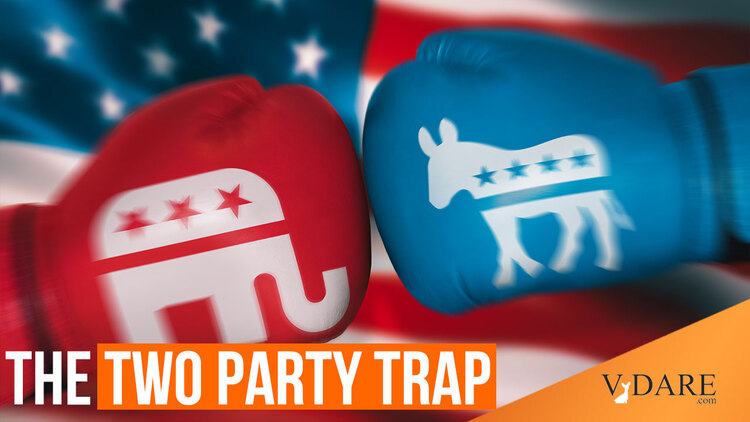
The Two-Party Trap In The U.S. And Britain
11/27/2023
For all the drawbacks of multiparty coalition-building government, they are at least spared the Two-Party Trap.
What’s the Two-Party Trap? Well, imagine you are a voter in a nation that’s had just two major parties alternating in government for as long as anyone can remember. Go on, just try to imagine it.
Sure, there are third parties you can vote for: but those two big parties have the mighty force of inertia on their side. Campaign funding has been directed to them for so long that huge, powerful blocks of voters are locked into them: labor unions on the left, for example, and big corporations on the right.
There’s an inertia of voter psychology, too; a reluctance to take third parties seriously. Heck, I’ve ALWAYS voted for the People’s Progressive Party. It’s the party of the Little Guy, isn’t it? Or contrariwise: I’m a National Salvation Party loyalist, same as my Dad. The People’s Progressives are just a bunch of commies.
Thence to the Two-Party Trap. What if you strongly favor some policy — immigration restriction, for example — but both the big parties oppose it? You can vote third party; but (a) they are poorly funded and not likely to win, and (b) at least the two big ones have lots of experience at operating the machinery of government. If that third party gets in, how long will it take them to climb the learning curve?
Britain’s voters face a particularly nasty version of the Two-Party trap in 2024. I apologize for falling back on the Old Country as a news source after last week’s Brit-a-thon, but the parallels here are obvious and instructive.
Under Britain’s constitution the Prime Minister has to call a general election before January 2025, although the precise date is his to choose. So 2024 is election year over there, same as over here.
And yes, there are two big parties over there: the Labour Party and the Conservative Party, aka the Tories.
There is also a significant third party, the Liberal Democrats. They actually formed a European-style governing coalition with the Tories from 2010 to 2015. That was highly unusual, though. The Liberal Democrats currently hold fifteen seats in the 650-seat House of Commons — less than 2½ percent.
Sure, the Lib-Dems might do better next year, but voter inertia will keep them down. Current polling has them at twelve percent; the Tories at 25, Labour at 46. It’ll be a two-party election.
Immigration should be a huge issue; all the huger because of figures released this week when the Office for National Statistics published the number for net immigration in 2022: 745,000 — nearly three-quarters of a million.
That is a sensational number, and a politically scandalous one for the Tories. Prior to the 2010 election, when the number was coming close to 300,000, Tory candidate David Cameron promised voters that if they elected a Tory government, net migration would be, “reduced to the tens of thousands.” .
Here was the first lie from the Conservatives on cutting Immigration on 11 jan 2010
Tories would limit immigration to ’tens of thousands’ a year, says Cameronhttps://t.co/SVxHeQaRkr
— Liam 🇬🇧🇬🇧🇬🇧🇬🇧 (@liam345) May 27, 2023
The Tories were duly elected; but the reduction didn’t happen. Five years later in 2015 the number was heading for 400,000. There was enough dissatisfaction over this to fuel the 2016 Brexit vote to leave the European Union, which voters thought would restore Britain’s ability to control its own borders.
The Tories continued in power down to the present day. Cameron resigned after Brexit, though, and a succession of Tory Prime Ministers followed, all of them promising to get net immigration numbers down.
None of them did so. When Boris Johnson resigned last July following scandals and rebellions in his party, the latest number was over 450,000 for 2021. Now we know that the number for 2022, Johnson’s last year, was 745,000.
Executive summary: After thirteen years of Tory government under five Tory Prime Ministers, every one of them vowing to get the immigration number down, starting from under 300,000 and a promise from the Tory candidate to get it down to five digits, it is today heading fast towards seven digits.
Inescapable conclusion: The Tory party is utterly useless at immigration control.
So what’s a British voter to do next year? If two-party inertia holds, which I hereby predict it will, he’ll vote for the Labour Party candidate.
What’s the Labour Party like on immigration? They love it! Let’s bring in more!
Legacy white British are now just 37 percent of the population of London. When I went up to college there in 1963 it was 97 percent. Other big cities likewise. Nationwide, legacy white British were 78 percent in 2019, likely 76 percent now. The Great Replacement is seriously under way over there.
So on an issue they are seriously troubled about, British voters next year face the Two-Party Trap. On immigration, the Tory Party is useless, the Labour Party worse than useless.
Disaffected Tory voters can’t stop the Great Replacement by voting. They can, however, vote Labour and thereby at least derive some grim satisfaction by poking their collective finger in the eye of the Tory Party. That is what they’ll do.
